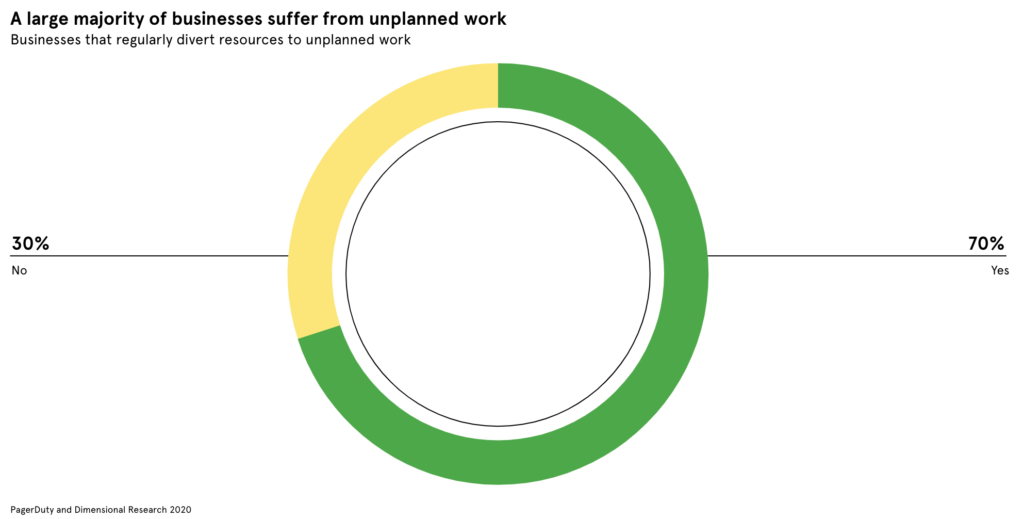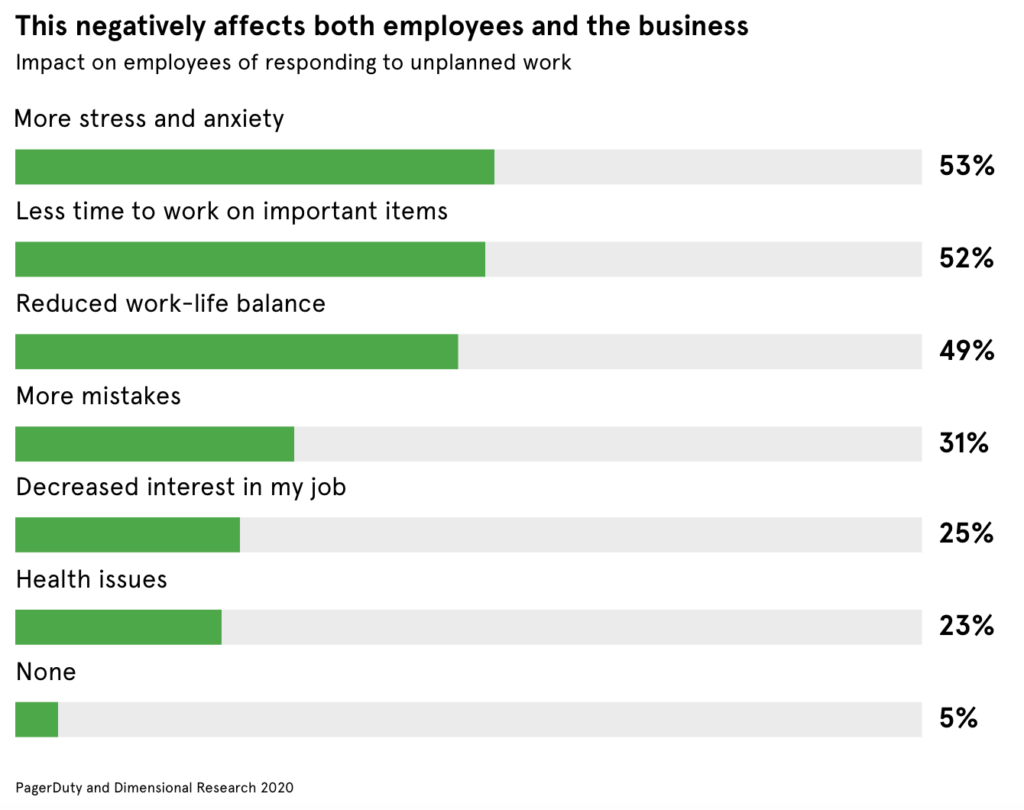- PagerDuty /
- Blog /
- ITOps & Modern Ops /
- 5 Ways Unplanned Work Is Disrupting Your Business
Blog
5 Ways Unplanned Work Is Disrupting Your Business
This article was previously published by Raconteur.
Unplanned work is rising, with consequences ranging from unhappy customers and lost revenue, to employee churn and burnout. So what is the true business cost of wasted time? In this blog, we will explore how one employee’s wasted time can impact the whole company—from operations, to development and beyond.

It happens to the best of us: a meticulously crafted plan thrown by the wayside as impromptu issues and requests crop up. With 77 percent of tech employees losing 100 hours or more of productivity due to unplanned work this year, according to PagerDuty research, exactly how is this hitting businesses and how can they combat it?

1. Operations: Get Off the Hamster Wheel
“Changing priorities within a business happens, but tackling it without losing stability and clarity can be achieved by defining departmental focus,” said Sarah Gilchriest, Global Chief Operating Officer at business training company Circus Street.
“We make sure every single department, from content to tech and production, to talent and wellness, has a focus and that we constantly communicate about it,” she explained.
“It’s also about the strength within your senior leadership team to bring those challenges to the fore and work out whether or not we should be tackling them, and how we reprioritize.”
Getting off the hamster wheel to define strategic goals takes confidence,” Gilchriest added, “especially when it involves pushing back on excessive client requests, which is a common source of unplanned work.”
2. IT: Resist the Loudest Person Shouting
From software defects to system breakages, unplanned work occurs daily in IT. The first lockdown is one example, where a third of IT leaders spent half their team’s time resolving remote-working issues, according to low-code app development platform Mendix.
“There’s no avoiding it,” said Pete Hanlon, Chief Technology Officer at call outsourcing specialist Moneypenny, so it’s important to resist defaulting to the loudest person shouting.
“The challenges with unplanned work can be hidden initially; although people are busy, they’re not working on the planned highest-value work. This then can have a knock-on impact to forecasts for resource, revenue and the next planned item on your roadmap,” shared Hanlon.
Moneypenny uses a delivery process, plus techniques such as automated testing, proactive systems monitoring with thresholds, and alerts to identify and address potential issues.
“If something is truly important and urgent, and we have a definition of this, then it can be expedited,” Hanlon added.
3. Risk: Expect the Unexpected
Risks by their nature are uncertain, making it common for incidents to arise that put a dent in an agreed plan and require reallocation of resources. This makes planning for the unknown something all sensible chief risk officers do,” said Chris Burt, Principal of Halex Consulting and Co-Founder of the Risk Coalition professional network.
“A good indication of successful planning is that all key planned deliverables are delivered on time while unplanned events are dealt with effectively,” said Burt.
“Being able to drop plans and manage the unexpected is a sign of risk management maturity. But if this happens overly often, it may be a sign that the risk function is not doing enough horizon-scanning or identifying new risks sufficiently early.”
4. DevOps: Par for the Course
Quickly responding to changing needs has become second nature for Lloyd Watkin, Principal Engineer at food-sharing app OLIO, who believes the trick is to organise your roadmap with a high degree of agility built in.
“The nature of the unplanned work could be small and contained. For example, we’ve recently had to revive our #Cook4Kids campaign to help feed children during half term, so we had to deploy some supporting messaging,” said Watkin.
“On the other hand, unplanned work can be more wide-reaching. It could be that we’d slightly sacrifice the timeline or feature set of an upcoming release, or we may think about changing the plan for our next sprint entirely.”
5. Customer service: Avoid Churn
Technology issues and problems with products or services can all impact customer service and lead to customers, as well as employees jumping ship,” shared Aileen Allkins, Microsoft’s former Vice President of Customer Service and Support.
“Customer service is already a highly stressful job; US contact centres have some of the highest staff turnover rates,” said Allkins. “Conversely, the link between employee satisfaction and customer satisfaction is well documented, so reducing unplanned work is vital.”
“An incident management program is key to understanding which requests can be automated to reduce the number of disruptions,” she explained.
“Success can be measured by regularly reviewing the number of unplanned support calls: the fewer calls, the happier your customers,” Allkins concluded.


